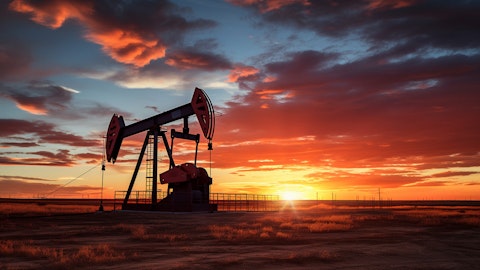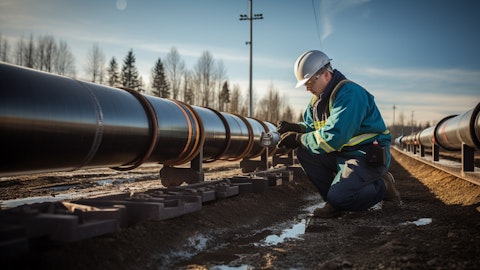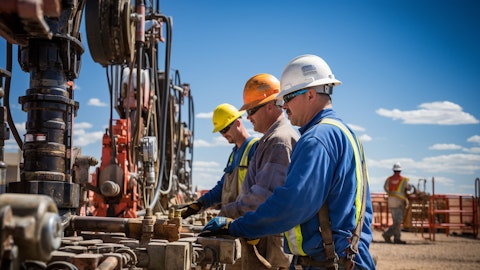In terms of renewable growth installed capacity, so this capacity grew by almost 6 gigawatts between 22 and 23 at more than 22 gigawatts at the end of the year, leading and contributing to produce more electricity. So, it’s an increase compared to last year by more than 80% at 19 terawatt hour broadly in line with the objective we had. So now on the emission side front, we reduced scope 1 and 2 from operated facilities to 34.6 million ton last year with two main drivers. So first, we continue to be successful in our efforts in oil and gas businesses to reduce gas flaring. I’ll give you the example, that in Nigeria, for example, we completely stop gas flaring at the end of 2023 and we are successful in developing energy efficiency projects.
On top of that, in 2023, 2023 was a more normal year in terms of CCGT utilization rates in 2022 for obvious reasons. We had a very strong decision rate for CCGT until 2023. It’s back to normal. And this contributes, of course, to lower the Scope 1 and 2 ‘22 versus ‘23. Methane from operated facilities were reduced by 47% compared to 2022, surpassing our reduction targets. And another very important key factor, which translates into figure our transition strategy is the lifecycle carbon intensity with a reduction compared to 2015 by 13%, with a target we posted at 12%, so more energy, less emission, but also growing cash flow. We exceeded our CFFO guidance by more than – by about $1 billion. The guidance restated using the same price deck as for 2023 was at $35 billion and so the final figure, as I already mentioned, is at $36 billion.
In terms of investments, we invested $16.8 billion last year within the guidance and I will come back on that later. And CFFO payouts already commented, above 40% at 46%. CapEx. So we remain disciplined in our CapEx, in our investments with a total of $16.8 billion in ‘23. We were very active in ‘23 on the M&A side. We have a very active portfolio management allowing to continue to enhance — to upgrade our portfolio. Because in this figure, $16.8 billion, of course, you had – it’s a net between organic CapEx, around $18 billion plus acquisition, so $6.4 billion of acquisition and $7.7 billion of divestments. So this figure, this $6.4 billion acquisition. So on the oil and gas side we have our entry for a 20% interest in SARB and Umm Lulu fields in Abu Dhabi.
We have, on the LNG side, our effective entry in a furnace in Qatar and Rio Grande Project in Texas [indiscernible] for LNG. On the integrated power side, the acquisition of the remaining 70% stake in Total Eren as well a 34% stake in a joint venture with Casa dos Ventos renewable developer in Brazil. And as you know, the main divestments are our exit or disposal of our Canadian assets with sales to Suncor and the sales to Conoco and the sale of our retail network in Germany to Alimentation Couche-Tard. So very strong portfolio management last year with strong figures. In 2023, in line with our balanced energy transition strategy, I remind you previously, we invested more or less the same amount of money in low carbon molecules, so mainly integrated power compared to what we did in oil.
So, it’s the red part of the pie compared to the green part of the pie. Another way we can look at it is that we invested as much in integrated and low carbon molecules as we did in new projects in oil or in gas new projects. For integrated power, the figure was $5 billion in ‘23. Progressing, in particular, in implementing our strategy in the regulated markets, particularly in the U.S. and in Europe. So, now moving to the highlights of ‘23. On our two pillars, all segments has big achievements and a strong performance last year, in line with our strategy and objectives. In upstream and gas, our production reached 2.48 million barrels of oil equivalents per day, benefiting from a startup in January of the Block 10 in Oman, Absheron in Azerbaijan in July as well as already mentioned, our entry in SARB and Umm Lulu in Abu Dhabi and our effective entry in the GGIP project in Iraq.
The company completed the divestment of its Canadian oil assets in line with the strategy to focus on low breakeven assets. For downstream, we generated $8 billion of cash flow last year. And so we kept – we were able this result is – or this figure is a result of the fact that we were able to capture high refining margins that averaged $69 per ton last year. In 2023, we awarded EPC contracts for the Amiral project, $11 billion contract. So it’s our petrochemical integrated complex in Saudi Arabia with Saudi Aramco that will come on stream in 2027. The company also announced the sale of some European retail network to Alimentation Couche-Tard. And so we completed the German portion before the closure and the remaining parts. So in Netherlands, in Belgium and in Luxembourg, it was completed early January 2024.
So we pursued our growing strategy in LNG, especially in the U.S., where we, once again, were the largest LNG exporter last year with more than 10 million tons of capacity and increased our future position to more than 15 million tons per year through our entry into the Rio Grande LNG project and its FID in July. We also reinforced our leading position in Europe ReGas with the startup of two additional FSRUs, so one in Germany, one in France. In Integrated Power business segments, we pursue our profitable growth strategy with an additional 6 gigawatts of renewable capacity. And we are able to generate more than $2 billion of CFFO, $2.2 billion compared to one – something like one last year. That means that we are able to more than double the CFFO generated by this activity over 2023.
In 2023 as well, we accelerated the development of our integrated business model in 2 key deregulated markets. the U.S. on one side, with the announcement of an acquisition of 3 CCGTs for 1.5 gigawatt capacity in Texas and in Germany on the other side, announcing the acquisition of 2 German companies, one the top-tier renewable energy aggregator and a leading battery storage developer. So we have built our upstream portfolio through the years with low-cost and sustainable way as illustrated, I think, by these 2 charts. So starting from the left, we’ll go back to 2018. We are consistently reporting the lowest upstream production costs among all the majors, which is, I think, a structural advantage and call us to be resilient even in a low price environment.





